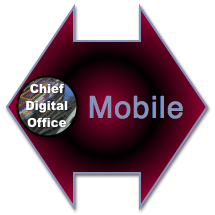 Ubiquitous Computing Primer reveals mobile’s ultimate business context and enables astute digital executives to create a whole new layer of value from their mobile investments. “Mobile” is far more important than launching smartphone and tablet apps because “smart” devices will interact with each other to provide a new level of capability and customer experience. This primer is a very brief treatment of a complex subject, so follow its links to drill down. Ubiquitous Computing Primer reveals mobile’s ultimate business context and enables astute digital executives to create a whole new layer of value from their mobile investments. “Mobile” is far more important than launching smartphone and tablet apps because “smart” devices will interact with each other to provide a new level of capability and customer experience. This primer is a very brief treatment of a complex subject, so follow its links to drill down.
In 2013, smartphones and tablets imply that people are interacting with each other and “the Internet,” but “mobile” is becoming a “feature” of all kinds of devices and products in a phenomenon called “ubiquitous computing.”
Ubiquitous Computing Primer is Part1 of The CDO Guide to Mobile for Digital Transformation.
[…]
How Brands Cut Their Exposure to Facebook Business Risk shows how brands can reduce the risks of depending on Facebook too much.

In the Facebook As Investment trilogy, I have analyzed several dimensions of investing in Facebook and raised my doubts about the company’s management and direction. In Part Three, I’ll address how brand executives can insulate themselves from Facebook’s—or any platform’s—fortunes by moving to make their relationships and networks portable. By making and managing investments carefully, brands’ relationships will endure regardless of platforms’ destinies.
By the way, Part One examined how Facebook’s trust gap would make it difficult for Facebook to fully monetize its considerable assets. Part Two analyzed Facebook as a social platform and revealed that it had no competitive threats from other pureplays; rather, the risk was that the whole pureplay category would lose its dominance in 3-5 years.
[…]
 Giving as Smart Business: Blake Mycoskie, Founder TOMS Shoes is a fantastic story and a smart business idea. Blake Mycoskie is a gifted storyteller in his own right, and, in this South by Southwest 2011 keynote, he entertained the audience with the story of TOMS Shoes while imparting a simple but profound principle of 21st century business: discovering the meaning and potential of giving. Here are the highlights of TOMS story, which will help you appreciate the context of the blockbuster business idea. Giving as Smart Business: Blake Mycoskie, Founder TOMS Shoes is a fantastic story and a smart business idea. Blake Mycoskie is a gifted storyteller in his own right, and, in this South by Southwest 2011 keynote, he entertained the audience with the story of TOMS Shoes while imparting a simple but profound principle of 21st century business: discovering the meaning and potential of giving. Here are the highlights of TOMS story, which will help you appreciate the context of the blockbuster business idea.
[…]
 2011 Social Business Predictions and Recommendations describes current social business adoption and advices firms and people how to get ahead. 2011 Social Business Predictions and Recommendations describes current social business adoption and advices firms and people how to get ahead.
2011 will be remembered as the year “social media” fell by the wayside, strategy became a recognized prerequisite for serious efforts, and “social business” began displacing it in boardrooms’ mindshare. “Social media,” which usually tries to use social technologies to talk at people, has been the predominant “first use” of socialtech because marketing drives most social initiatives, and marketers “communicate,” i.e. push content, to their targets. When they “listen,” they use limited legacy processes such as focus groups, email marketing, data mining and online surveys. However, none of these scratch the real itch because they emphasize the company asking individuals structured questions; they don’t allow customer to customer interaction, which is ten times more illuminating because it is spontaneous and customer-centric.
Socialtech gets there, but marketers are ambivalent about it because it means a loss of control. And more profits and career growth for marketers, but they have to let go first. It’s a leap of faith, but […]
Thoughts on Facebook 2.0, in which Facebook connects users’ social graphs to the Web, gaining a quantum leap more information about them […]
Quick guide for time-strapped executives to outperforming rivals this year by using LinkedIn, blogging and Twitter. Extensive links to free executive guides to social networks […]
One of key factors in driving Facebook’s explosive growth is the company’s genius globalization strategy. Most of its members are outside the U.S., and it powered past MySpace, the global leader for years, by using a crowdsourcing. This post compares MySpace’s legacy international strategy with Facebook’s Web 2.0 community strategy. […]
How to avoid lame updates on Facebook – debunking Wall Street Journal article […]
Why Twitter was one of the Web 2.0 innovations of the decade.. analysis and conclusions about Twitter’s value proposition for changing the economics of the Relationship Life Cycle […]
Drive customer engagement and brand value by focusing on the experience of using your product or service. This is the manna of word of mouth and social computing conversations. […]
|
|
 Ubiquitous Computing Primer reveals mobile’s ultimate business context and enables astute digital executives to create a whole new layer of value from their mobile investments. “Mobile” is far more important than launching smartphone and tablet apps because “smart” devices will interact with each other to provide a new level of capability and customer experience. This primer is a very brief treatment of a complex subject, so follow its links to drill down.
Ubiquitous Computing Primer reveals mobile’s ultimate business context and enables astute digital executives to create a whole new layer of value from their mobile investments. “Mobile” is far more important than launching smartphone and tablet apps because “smart” devices will interact with each other to provide a new level of capability and customer experience. This primer is a very brief treatment of a complex subject, so follow its links to drill down.

 Giving as Smart Business: Blake Mycoskie, Founder TOMS Shoes is a fantastic story and a smart business idea. Blake Mycoskie is a gifted storyteller in his own right, and, in this South by Southwest 2011 keynote, he entertained the audience with the story of TOMS Shoes while imparting a simple but profound principle of 21st century business: discovering the meaning and potential of giving. Here are the highlights of TOMS story, which will help you appreciate the context of the blockbuster business idea.
Giving as Smart Business: Blake Mycoskie, Founder TOMS Shoes is a fantastic story and a smart business idea. Blake Mycoskie is a gifted storyteller in his own right, and, in this South by Southwest 2011 keynote, he entertained the audience with the story of TOMS Shoes while imparting a simple but profound principle of 21st century business: discovering the meaning and potential of giving. Here are the highlights of TOMS story, which will help you appreciate the context of the blockbuster business idea. 2011 Social Business Predictions and Recommendations describes current social business adoption and advices firms and people how to get ahead.
2011 Social Business Predictions and Recommendations describes current social business adoption and advices firms and people how to get ahead.